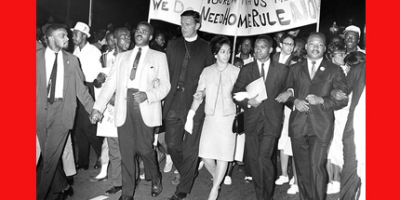Home Rule and Congressional Voting Rights
Martin Luther King and Walter Fauntroy march for Home Rule
Fauntroy’s agenda was the home rule legislation that had been stuck in the House, specifically in the House District Committee, chaired by John McMillan, a Dixiecrat from South Carolina, known as “Johnny Mac.” Fauntroy began building support for the home rule legislation as soon as he arrived, and he formed a strong working relationship with the Self-Determination for D.C. Coalition that continued and expanded the advocacy of the city’s long-standing Home Rule Committee. In 1972, he also took busloads of DC residents to McMillan’s Congressional district where they registered African American voters and campaigned against McMillan. After Johnny Mac’s defeat, Charles Diggs of Detroit and Chair of the Congressional Black Caucus, took the helm of the House District Committee. His leadership and the lobbying of the Self-Determination for DC Coalition, which had advocates across the country, made it possible for DC home rule to become a reality.1
In the fall of 1974, for the first time in 100 years, DC voters went to the polls to elect their local government—a Mayor and 13 Councilmembers. One of the new Councilmembers elected was Julius Hobson, who had run as the DC Statehood Party’s candidate for an At-Large Member. In 1976, Hobson along with 11 cosponsors introduced legislation calling for a referendum on statehood. But when he tried to move the bill, Marion Barry and David Clarke were the only Councilmembers who supported it. DC’s political leadership was ambivalent about statehood, and, for the most part remained so for decades. Statehood was merely tolerated by the city’s political leaders. Their attitude was one of forbearance. Hardly anyone spoke against it, and even Mayor Walter Washington found it “interesting.” But it would be nearly 40 years before, DC’s political leaders invested political capital or significant financial resources in statehood.2
In the seventies, DC political leaders and residents alike were enthusiastic about the prospect of gaining representation in Congress, a cause championed by Delegate Fauntroy. Working with the Self-Determination for DC Coalition, Fauntroy managed to get the DC Voting Rights Amendment (D.C. VRA) passed by two-thirds of both the House and the Senate.The bipartisan group of supporters included Senator Strom Thurmond of South Carolina and several other conservative Republicans. In 1978, as the Amendment was sent to the states for ratification, Washingtonians were confident that it would be ratified by the required 38 state legislatures before the seven-year deadline.3
1 Michael Fauntroy, Home Rule or House Rule: Congress and the Erosion of Local Governance in the District of Columbia (Lanham, MD: University Press of America, 2003), 41–44
2 “Tucker, 2 Moores, Hobson Sr., Barry Lead City Council Race,” Washington Post, Nov 6, 1974; “Bill for D.C. Statehood Backed,” Washington Post, Feb. 26, 1976; https://samsmitharchives.wordpress.com/2006/11/10/bush-lost-but-we-havent-won-2/
3 “Statehood Is Far More Difficult,” Washington History, Fall 2017; Johnny Barnes, Legislative Counsel for Walter Fauntroy, phone interview with Elinor Hart, April 14, 2020.
Where to Find Us:
New Columbia Vision
1651 HOBART ST NW
Washington, DC 20009
Phone: 202 387-2966
What's New
Extended business hours
To accomodate our customers' busy schedules, we have extended our hours and are now open later.
Special Facebook Promotion!
Like us on Facebook and get 10% off your next order.


